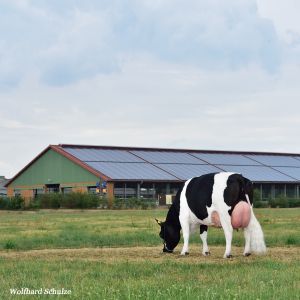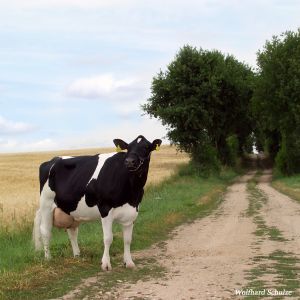Black & White dual purpose

The German Black & White dual purpose cattle used to be widespread and is now one of the endangered breeds
The German Black & White dual purpose (DSN) is the original breed for today's German Holstein breed and is still kept as a genetic reserve. It was once the most important cattle breed in Northern and Central Europe and was native to the marshland and lowland areas in the Dutch-Frisian North Sea region more than 150 years ago. The cows were supposed to be highly adaptable to different site conditions. In addition to the suitability of the breed for milk and meat production, the high adaptability to different site conditions was important.
For this breed, a good milk yield with a high fat content as well as a good beef performance were desired. At the same time, they should be undemanding in terms of feeding and do well on marshy soils. The animals themselves were deep and broad in their conformation. The North American Holstein Friesian breed can also be traced back to the Black & White cattle of Dutch, German and British emigrants.
In the early 1960s, cryopreservation and long-term storage of bovine semen created entirely new conditions for the exchange of genetics across continents. It took only a few years before the use of dairy-focused North American bulls in Western Europe led to the Holstein Friesian that dominates today.
Nowadays, the old Black & White breed is only kept on a few farms. It is most widespread in Brandenburg. Since 1972, it has been bred there with an independent breeding programme.
In Brandenburg, the Genreserve Deutsches Schwarzbuntes Niederungsrind e.V. association and RBB Rinderproduktion Berlin-Brandenburg GmbH are working to preserve the DSN. The state of Brandenburg, but also other federal states, offer subsidies for the preservation of this old and endangered breed.
Breeding is carried out with the aim of securing a genetic reserve of living animals, strongly limiting inbreeding and further developing the population with modern breeding value estimation methods. The difference in performance between German Holsteins and DSN under comparable conditions is currently around 2,000kg milk.
The breed is particularly suitable for the management of pasture and nature reserves, for organic farms and for extensive production conditions with a high proportion of on-farm fodder production.
Breed description
In their outward appearance, DSN cattle are resembling the German Holsteins, especially in the coat colour. Nevertheless, this breed is more uniform in itself. DSN are regularly black and white coated, genetically horned cattle. Head, neck, chest and rump are black, whereas the legs up to the carpal and hock joint, the belly and the udder are always white. The classic body markings consist of a white chest and rump band and a large black area in the middle of the body. The dorsal line is never white throughout. Small uneven black and white spots on all parts of the body are not desirable. The claws should be as black as possible. Due to the width of the forehand, the rump, the back and the spring of the ribs, the body of the animals is round.
The breed has a high intake capacity of farm-grown forage, a good grazing ability and a calm temperament. The calving interval is 365-380 days. A table-shaped, wide, slightly inclined rump ensures easy calving. A good milkable udder is desired, which allows high performance in quality and functionality over many lactations and is suitable for all milking systems. A balanced conformation with good depth and width as well as good to very good back and leg muscling characterise this breed as well as correct feet and legs for best locomotion in all types of husbandry.
Breeding Goal

Due to its dual-purpose characteristics and its undemanding nature, the DSN breed is ideal for extensive cattle husbandry.
For the DSN a good milk production in all husbandry systems as well as a good carcass quality of male and female animals is aimed at. The cows have a genetic milk yield potential of 7,000kg to over 8,000kg milk at 4.30% fat and 3.70% protein. The milk yield is to be realised to ¾ from grass and maize silage. The cows reach a weight of approx. 650kg with a height ( height at sacrum) of 138cm. For bulls, a weight of 1,100kg at a height of 150cm is targeted. The fattening bulls should achieve daily gains of 1,000g - 1,300g per day.
The breed is a genealogical ancestor of all of today's Black and White dairy cattle. Breeding work aims to secure the existing genes (cattle, semen and embryos) of this breed in the sense of genetic reserve and to limit inbreeding. A supply of genes from other populations of the same breed is possible. No more than 10% HF genes are tolerated for the breed designation DSN and the breed code 10.
Further information about the breed DSN can be found on the pages of the RBB and the VOST.










